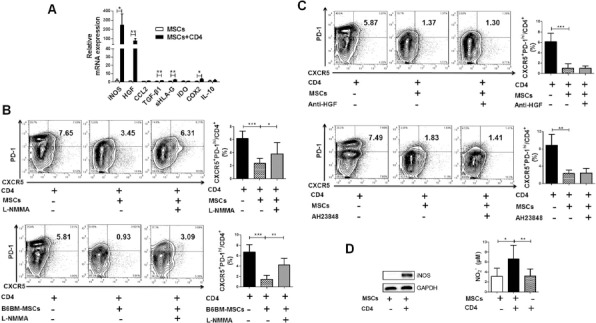Figure 4.

The inhibitor of inducible nitric oxide synthase (iNOS) partly restored the generation of mouse Tfh cells. (A) Real-time polymerase chain reaction (RT-PCR) showed that the expression of iNOS in hUC-MSCs was significantly increased after coculturing with mouse CD4+ T cells. (B) NG-methyl-L-arginine acetate salt (L-NMMA), the inhibitor of iNOS, reversed the suppression of hUC-MSCs (n = 4, top) and bone marrow MSCs of B6 mice (B6BM-MSCs) (n = 3, bottom) on Tfh cell generation. (C) Anti-hepatocyte growth factor (HGF) treatment (n = 1, top) or prostaglandin (PG) E2 blockade (AH23848, n = 4, bottom) could not recover the generation of mouse Tfh cells. (D) Western blot analysis confirms the activation of iNOS in hUC-MSCs being cocultured with CD4+ T cells and nitric oxide (NO) production in the culture supernatant of hUC-MSCs-CD4+ T-cell cocultures elevated markedly than that of hUC-MSCs or CD4+ T cells cultured alone. *p<0.05; **p<0.01; ***p< 0.001. Western blot data were representatives of three independent experiments, and other data were pooled from three independent experiments. CCL2, chemokine (C-C motif) ligand 2; TGF-β1, transforming growth factor-β1; sHLA-G, soluble human leukocyte antigen-G; IDO, indoleamine 2,3-dioxygenase; COX2, cyclooxygenase 2; IL, interleukin; CXCR5, C-X-C chemokine receptor 5; PD-1, programmed cell death-1; GAPDH, glyceraldehyde 3-phosphate dehydrogenase.
